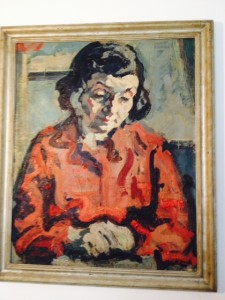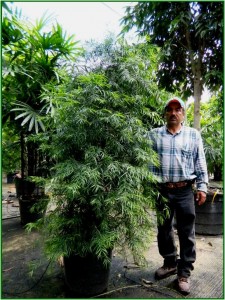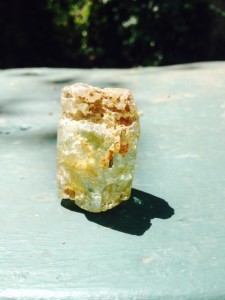I’m in my midtown apartment, sunlight streaming through the south-facing windows, and I’m watering Grete Sultan’s cactus, which I saved from being abandoned on a street corner in the West Village.
A few days after her death, I went to Grete’s apartment in Westbeth–the former Bell Labs building in the far West Village converted to artists’ housing– where she’d lived since it opened in 1970. Back then, I’d helped her move some of her things there from the apartment on 2nd Avenue and East 18th Street that she’d shared with Vera Lachmann and Tui St George Tucker.
After Grete’s death in 2005, her niece Marianna was clearing out the apartment. All of the plants were gone, except for the cactus. No one wanted it, and as she was on her way back to St Louis, Marianna said she’d have to take it downstairs and leave it on the street. I said I’d take it home with me, and lugged it down to my car. Since then it’s been living –and getting bigger and bigger– in the southern light of my midtown apartment. Its existence makes me happy in a very personal way, as if some part of Grete is here with me, and I take special pleasure in seeing how it’s flourishing and sending out lots of new growth —it seems to like the new, bigger pot and the tall dowels I bought to keep it upright.

Portrait of his Wife by Franz Rederer. One of the many Rederer paintings and etchings that hung in Grete’s studio.
Grete’s studio in Westbeth was an amazingly place—paintings and drawings by the Swiss artist, her close friend Franz Rederer, of Grete, her mother, Alban Berg, Edwin Fischer and Tui St George Tucker; etchings by John Cage; abstract paintings by Beate Wheeler and Spencer Holst; evocative photos of colleagues, teachers and friends; the wonderful lamp she’d made out of a
bamboo pole and a huge translucent shade with a wooden salad bowl as a base; her Steinway and Mason and Hamlin grand pianos; her amazing collection of rocks, gemstones and crystals– and all those plants! The huge old Westbeth windows angled toward the river, and window sills and the areas in front of them housed her extraordinary plant collection: a huge podocarpus, a group of cacti, and lots of little offshoots being rooted according to a mysterious technique I still hear her refer to (in her memorable and unique Berlin-accented English) as “Chinese air-layering.”
As I refill the watering can, I think of all the wonderful music this cactus heard in its years in Grete’s studio: her signature pieces like Bach’s Goldberg Variations, Beethoven’s Diabelli Variations, Schoenberg’s Five Piano Pieces; and all the music written for or first performed by Sultan, likeStefanWolpe’s Form, Henry Cowell’s The Harp of Life, John Cage’s Etudes Australis…and the extraordinary conversations—with Wolpe, Lucia Dlugoszewski, Ben Weber, Christian Wolf, Spencer Holst, Alberto Ginastera, to name just a few of those I met there. And John Cage, one of the first people she met in America after her harrowing escape from Nazi Germany in 1940–playing chess, working with her on the Etudes Australis, which he wrote for her, and to whose extraordinary complexities and beauty she devoted probably the better part of ten years of her life, performing them while touring with Cage all through America, Europe and the Far East.
I continue watering–more free-association…bringing my first opera to show to John Cage at his apartment on West 18th Street. You walked in, and there was that long, narrow room filled with his lush and lovingly tended collection of plants—so similar to the plants in Grete’s studio, as if the two of them had studied metaphysical horticulture with the same teacher, which, in their many years of friendship and artistic collaboration, in some way, they probably had done.
And chess. The legendary short story writer and painter Spencer Holst lived five floors down from Grete—they’d known each other since the 1950s. In Grete’s last years, Spencer came up every night for a game of chess. When I would visit Grete in the evening, as I often did, at a certain point, the phone would ring, and it would be Spencer asking if it was time for him to come up for their game.
Cage and Sultan played chess, in her apartment and in his, and on the road with a portable chess set when they toured together. This went back a long ways. In the 1940’s, Grete’s mother lived with her in a loft building in Chelsea. Cage and Merce Cunningham were their downstairs neighbors. Grete’s mother was part of an illustrious and wealthy Berlin family, had known and entertained many of the prominent artists of her day, and was now, as a refugee, living a very different sort of life in New York. She loved to play chess, but after a long day of teaching, Grete was often too tired for a game. So Grete’s mother got John to come up and play with her. He was hooked– it was through those regular games with Grete’s mother that Cage became fascinated with chess; I think Grete even said that it was her mother who actually taught him how to play.
This is around the time when Cage got to know Duchamp, and it at that point that Duchamp announced that he was abandoning art for chess. So we have Cage asking Grete’s mother to teach him about chess just when he’s getting to know Duchamp and just when Duchamp is so occupied with chess…how does this all connect? Was Grete’s mother the lucky recipient of a steady chess partner because of Duchamp’s influence? Or was John’s initiation into chess by Grete’s mother a happy accident that led him to be more receptive to Duchamp’s thinking?
more on Cage/Duchamp under COMPOSERS



Enjoyed this. Just discovering Sultan.